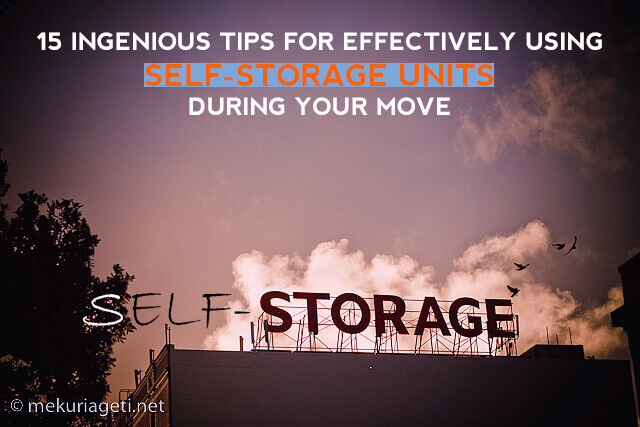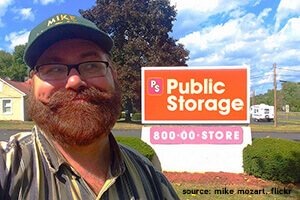
source: mekuria getinet
Self-storage can be a perfect solution for your relocation needs, especially in case your are downsizing your home, move-in together with your spouse or simply need more space for a certain period in your life. If wisely chosen, you summer or year-round storage can be truly beneficial – you have some of your valuable possessions safely stored, easily accessible near your place, until you find solution to your space problems at your (new) home and get them back with you. And while in most cases a convenient solution, paid self-storage is a complex matter, hiding many pitfalls beneath its surface, and falling into them might prove to be costly, not to mention the additional stress and wasted time that goes with it. With the following tips we are trying to help you stay on the safe side and make practical decisions, concerning your upcoming self-storage adventure.
- Use Suitable Boxes and storage containers. The very first thing to do, even before starting your hunt for suitable self storage unit, is to pack the items you’re going to place in short or long term storage in suitable boxes and storage containers. Get them for free or purchase high-quality boxes, which can last longer and will effectively protect your belongings for a long period (the tricky part of self-storage is that you can never know for certain how long your items are going to stay there), and will not fall apart after just a few weeks or so.
- Label extensively. Even when you pack all your items-to-be-stored by yourself and you know exactly what lies in each box, that will not be the case in just a couple of months. You don’t have to find this the hard way, digging and opening box after box for ages until you find this small valuable item you’re after, just to realize that your even more precious time is lost. Label everything, even the most obvious ones, and even make yourself a list to hang on the door, reminding you where you may find something tricky (e.g. old rock-and-roll vinyl records for your online auction).
- If you don’t need it – don’t store it. Storing your items could be expensive. Really expensive. Why making the things even worse by paying for storing things which you will most likely never going to use again? Consider your decision to rent a storage unit as a good opportunity to clean your home of all unneeded objects. Donate some to charity organizations, sell others through a garage sale or give them away as presents to friends – the options are endless. The ultimate goal is to optimize your storage expenses.
- Never store these. To avoid wasting time in packing items that would finally cause problems, do not store: perishable food, toxic substances, flammables (oil, paints, gasoline) or wet items, which may cause water damage and development of mildew, mold and fungus.
- Choose an appropriate storage unit size. This is a crucial choice to be made, especially when you’re trying to optimize every single dollar out of your self-storage and relocation project. The bigger the storage unit – the higher its monthly rate will be. You don’t want the storage cell to be either too large (you’ll end up paying extra for an unused space), nor too small (you won’t be able to fit all your items). If you’ve followed our first tip, you have all your items packed and you’ll be able to figure out what size of self storage unit you are going to need, or ask the storage company specialists to recommend the right unit for you. The next tip will also be helpful in solving this dilemma.
- Draw a plan of the space. This is plain simple. Collect information on the sizes of the storage units which may suit your needs and draw a floor plan where each box will be placed. Do not forget to take the height of the cube into consideration and make drawings of how your boxes should be stacked. This will not only help you optimize your storage space, but also can be used as a treasure map of where each box is stored.
- Divide and optimize the space. It is strongly related to the tip above – you need to plan a clear path (or paths, when possible) in your storage unit, so that each box can be easily accessed if you need to take something out of it in the future. You don’t want to waste your time putting down and arranging boxes back every time you need just to quickly access a single item.

Paid public storage services can be a brilliant relocation solution, if used wisely!
- First in – last out approach. Another plain simple one, but we need to be sure we’ve mentioned it. Quite often you are only going for a short-term public storage, matching the duration of your move. In this case, you should plan to put the items you’re going to need first closer to the door (stored last). Also, if you are going to use the storage unit as an extra storage space for some time, keep the most frequently used items at the front.
- Dismantle the furniture. Storing bulky furniture items can quickly consume your free space, but most of them can be dismantled into less space-consuming pieces (and we don’t only mean your DIY IKEA style bed or table). Keep the disassembled items together, carefully wrapped up to avoid scratches and dents. Put the small items, such as bolts, screws and hinges in a plastic bag or a small box, attached to the corresponding furniture piece and ready to be put back together when the time comes.
- Let your items “breathe”. When arranging your boxes in the storage unit, avoid pressing them firmly to the walls. Leave about an inch for proper air circulation. Also, in places with high humidity and big temperature deviations, droplets of condensed moisture may appear on the walls, wetting your boxes and even damaging the items stored in them.
- Protection against climate changes. Although this may not be valid for some parts of the continent, there are items sensitive to harsh temperatures and need to be stored either in a climate-controlled storage units or packed and insulated accordingly. Antiques, cosmetics, electronics, musical instruments, vintage photos, and anything else that may become less impressive when not stored properly, should be considered for extra care storage option on not stored at all.
- Use the space inside drawers and large appliances. When talking about space optimization, most of us forget how much space there is left unused in some furniture items and big appliances. For example, drawers are an excellent place to store small or fragile items, wardrobes are perfect for storing boxes inside, while kitchen appliances, such as ovens and refrigerators can be used for storing smaller packed containers.
- Choose the right location. The location of the storage facility is important both for its rental price and purpose. Usually, storage locations in big cities are more expensive than those in rural areas, but there are exceptions to this rule, as well. If you are going to use the storage unit as a long-term storage space with frequent access to it, then it is better to be located near your new home, within city limits. If you’re planning to use it as a temporary solution, then you should decide if it would be more convenient to have it near your old or new home. In both cases you should compare the prices before making the final decision, as the difference can be substantial.

Yes! But not before you have made a clear decision about where and how you’re going to use it.
- Carefully read your self storage agreement. Try to read your storage rental agreement in full prior to signing it. Especially those parts in fine print. The contract should be as clear and unambiguous as possible, easily comprehensible for you, in order to avoid future problems with your storage company and stay protected from incurring some unexpected extra storage costs from hidden administrative fees or penalties.
- Ask for discounts. If you are aiming at a cheap storage solution and fall into a certain customer group – ask for your storage discount. Many of the storage companies offer discounts for students, military personnel, members of local organizations, etc. Some storage companies may offer a discount if you pay the amount of your contract upfront, not on a monthly basis.

